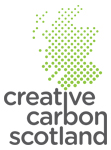In November 2019, the second transnational meeting of Cultural Adaptations was held in Gothenburg, Sweden.
Here, Creative Carbon Scotland’s culture/SHIFT Producer, Gemma Lawrence, writes about some key learnings shared by Swedish cultural partners, TILLT, on day 2 of the meeting.
TILLT’s roots go back more than 100 years when the theatre company Skådebanan was founded in Stockholm in 1910. Since then the organisation has evolved to focus on creating a society where art contributes to human growth, leading to a better, more creative and sustainable society. For the past 17 years TILLT has been running projects addressing societal issues with artists playing a key role as creative change makers.
TILLT supports this vision by creating projects where artists and organisations collaborate to develop creative processes around key topics including leadership, innovation, values and diversity. Their work is also guided by important societal issues such as diversity and integration, elderly care and climate change. TILLT believe that artists have a special role to play in these situations by creating space to say new things, have new thoughts and bring new mindsets to challenging and complex issues.
Key project phases
On the second day of the transnational meeting, Maria Mebius-Schröder, TILLT’s Project and Process Manager, presented the key stages of setting up such collaborations. This was pertinent to Creative Carbon Scotland’s culture/SHIFT programme and Cultural Adaptations, which involves four new collaborations between artists and climate adaptation projects across the partner cities in Dublin, Glasgow, Ghent, and Gothenburg. Maria outlined the key project phases:
Phase 0: Project anchoring
- Needs analysis jointly led by the process manager and commissioning organisation
- Assignment of the project group, e.g. ambassadors from the commissioning organisation who will act as advocates for the project
- Communication of the role of creative approaches brought through the artistic process led by the process manager
- Agreement of the working culture of the project with the commissioning organisation
- Artist recruitment led by the process manager
Phase 1: Research and development of project scope
- Research, participant interviews and observation undertaken by the artist with project participants
- Relationships and trust built between artist and commissioning organisation
- Development of an action plan by artist and commissioning organisation
Phase 2: Project delivery
- Project kick-off and communication of action plan including opening event with key partners
- Delivery of action plan
- Regular meetings between the project group, artist and process manager to check up on progress, arising problems etc.
Phase 3: Evaluation of the project and results
- Evaluation of project outcomes led by process manager
- Web survey undertaken by participants
- Discussion of future plans and opportunities for future collaboration
Although not included in the project phases, we also discussed pre-Phase 0 – project financing – which can be a lengthy process to secure the funds for both the artist and TILLT’s involvement in the project.

Key learnings
Building trust
TILLT were open about the failures they have experienced in setting up new types of collaboration between arts and non-arts partners, which have played an important role in shaping their currently project methodology. For example, they identified that they left too much up to the commissioner and artist in earlier projects, and now place greater emphasis on the role of the process manager in building trust and overseeing the process. The process manager can bring additional benefits including increasing the scope and ambition of projects, but also adds to the overall cost, so their role needs to be communicated and understood. This is something that we have learnt in our culture/SHIFT programme, where we now play a stronger role as a contributor throughout projects, not just in the setting up stages.
Maintaining artistic freedom
Maria also emphasised the importance of maintaining the space for artistic freedom, which can sometimes feel in tension with the aim of meeting an end goal or outcome. TILLT is very clear that they do not get involved in steering the artistic process, and the anchoring phase is key to creating the right conditions for the artist to bring their different way of thinking and working to shape the project. In their recruitment process, TILLT focus less on artform and more on the mindset and what they describe as the “driving forces” behind the artist’s work.

The rest of our time in Gothenburg included site visits and meetings with other actors engaged in making Gothenburg a more sustainable and climate resilient city including Kokokaka, a design studio based in an industrial warehouse in the port of Hisingen Island, and Björn Siesjö, Gothenburg City Architect. On the third day of the meeting TILLT hosted a day of presentations and workshops at the Museum of World Culture. This included Pecha Kucha style talks from each of the city embedded artist projects and a Climate & Creativity workshop where new ideas ideas for projects were developed between local adaptation stakeholders and international partners addressing key climate-related issues.
We’re very grateful to TILLT for such a rich and interesting three days of learning, discussion and exchange. We’re certainly taking a lot away from the meeting to apply to Creative Carbon Scotland’s culture/SHIFT programme, including the importance of building enough time at the start of projects for everyone to be clear of the aims and the commissioning organisation to be able to embrace the new approaches brought by the artist, and the value that the process manager can add at this stage.














